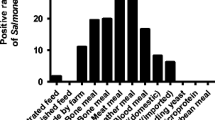Abstract.
Animal feeds can potentially become contaminated with foodborne Salmonella either during harvesting, processing at the feed mill or during storage. Any environment that comes in contact with feed during these stages that also harbors Salmonella can theoretically contaminate the feed. This also holds true for ingredients that are combined with feeds as they are being mixed at the feed mill. Animal feeds are also potential reservoirs for cross contamination from Salmonella containing vectors and environmental sources while being fed to animals. Although several factors may determine the extent of contamination, the potential for infection in animals these have not been well characterized. In addition, certain animal management and feeding programs can lead to animals becoming more susceptible to Salmonella colonization and invasion. Control measures to limit Salmonella contamination of feed include agents that directly reduce or destroy the organism in feed. Antimicrobial compounds and management strategies have also been developed for preventing colonization and eliminating Salmonella colonized in the gastrointestinal tract. The future prospects for minimizing Salmonella contaminated feed will probably involve combining more efficient monitoring and sampling approaches with more rapid and sensitive detection technologies.
Zusammenfassung (Redaktion).
Futtermittel können schon bei der Ernte der Futterpflanzen sowie während der Futter-Herstellung oder -Lagerung von Salmonellen kontaminiert werden; grundsätzlich kann dies überall dort passieren, wo Futtermittel mit der Außenwelt (mit Salmonellen) in Kontakt kommen. Dies gilt ebenso für Zusatzstoffe, die den Futtermitteln in Futtermühlen beigemengt werden. Futtermittel sind auch potenzielle Reservoire für die Kontamination mit Salmonellen während des Fütterns von Tieren. Obwohl das Ausmaß einer solchen Kontamination mit Salmonellen von etlichen Faktoren bestimmt wird, sind die Umstände, die zur Infektion der Tiere führen können, noch nicht ausreichend charakterisiert worden. Außerdem können bestimmte Tierhaltungs- und Fütterungsverfahren eine Infektion von Tieren durch Salmonella sogar begünstigen. Um dieses zu verhindern, können Wirkstoffe eingesetzt werden, welche die Salmonella-Populationen im Futter reduzieren oder zerstören. Es wurden ebenso Verfahren mit antimikrobiell wirksamen Stoffen entwickelt, um eine Besiedlung des Gastrointestinaltraktes durch Salmonella zu verhindern bzw. dort bereits vorhandene Samonellen abzutöten. Zukünftig muß ein effektiveres Monitoring- und Probenahme-Verfahren mit schnelleren und empfi ndlicheren Nachweisverfahren kombiniert werden, um eine eventuelle Kontamination von Futtermitteln durch Salmonella zu minimieren.
Similar content being viewed by others
Author information
Authors and Affiliations
Corresponding author
Rights and permissions
About this article
Cite this article
Maciorowski, K.G., Herrera, P., Kundinger, M.M. et al. Animal Feed Production and Contamination by Foodborne Salmonella. J. Verbr. Lebensm. 1, 197–209 (2006). https://doi.org/10.1007/s00003-006-0036-z
Issue Date:
DOI: https://doi.org/10.1007/s00003-006-0036-z




